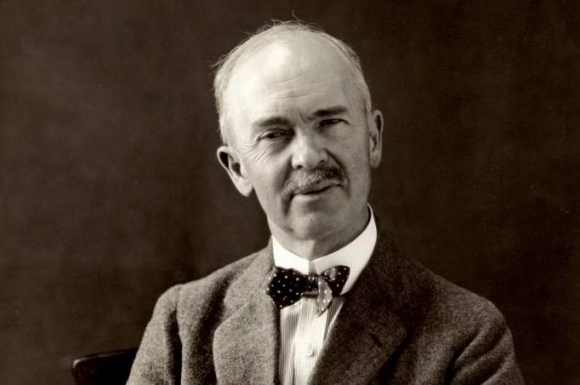
Biography
Edward John "Jay" Hambidge (1867-1924) ran away from his home in Simcoe, Ontario,Canada at a young age, escaping his large family and finding himself a job as a surveyer’s helper in Iowa. He later had a brief stint working as a printer’s devil (essentially, a young apprentice) and eventually became a reporter at the Kansas City Star. Hambidge and his family moved to New York City where he obtained a job at the New York Herald. By night, he attended the Arts Students League between 1893 and 1897, where one of his teachers was impressionist painter William Merritt Chase (1849-1916).
But Hambidge’s theories would prove to far overshadow any of the illustrations and paintings he created for books and magazines, including Century, Collier’s, St. Nicholas, Harper’s Monthly, Scribner’s, and McClure’s.[1]
While working on an article for Life magazine with Peter McArthur, Hambidge became interested in Greek architecture and the mathematics behind its aesthetics. His analysis of Greek art led Hambidge to the "re-discovery" of Dynamic Symmetry, the law of natural design based upon the symmetry of growth in man and plants. By studing the proportions utilized in everything from Greek vases to architecture, he found that many of these elements sustained the Golden Ratio (1.618): a proportion that is often organically produced in nature. Hambidge published his findings as a series of lessons in his magazine, The Diagonal, which were later compiled into the book, The Elements of Dynamic Symmetry. When Hambidge later studied contemporary art, he observed that the perfect forms from nature were being applied to art already, even if unconsciously.
Elaborating and refining his theory during the next 10 years, Hambidge traveled and taught widely at the most prestigious American universities including Yale and Harvard, stridently preaching that the universal application of these proportions would achieve beauty and harmony. When the theory caught on, Hambidge became recognized as “central in the Golden Section's revival as a design methodology.”[2] On January 20, 1924, the artist died while giving a lecture on his theories.
The theorist published his re-discoveries in a number of books on dynamic symmetry throughout his career. After writing Dynamic Symmetry and the Greek Vase and Dynamic Symmetry and the Greek Parthenon, his contemporaries, including Robert Henri (1865-1929) and George Bellows (1882–1925), began to take interest and employed the ratio in their own work. [3] The artist is credited with having influenced many other artists as well, including, Maxfield Parrish (1870–1966), Al Nestler (1900-1971), New Yorker cartoonist Helen Hokinson (1893-1949), and Clay Wagstaff (1964-). Norman Rockwell (1894-1978) also experimented with Dynamic Symmetry but found its mathematical specificity too restrictive.
Entry written by Bailey Pfohl, 2016 Walt Reed Distinguished Scholar Intern
Additional information added by Mark Hambidge Brewer – great grandson to Jay Hambidge. The photo of the artist is used with permission from Mark Hambidge Brewer.
Footnotes:
[1] Walt Reed, The Illustrator in America: 1860-2000 (Society of Illustrators, 2001), 77.
[2] Thomas Detrie, "Gestalt Principles and Dynamic Symmetry Nature's Design Connections to Our Built World." Arizona State University. 2002. http://www.public.asu.edu/~detrie/msj.uc_daap/article.html
[3] Ramon Sandino, "The Golden Ratio." Ramon Sandino. http://ramonsandino.com/goldenratio/index.html
Illustrations by Jay Hambidge
Additional Resources
Bibliography
Hambidge, Jay. The Elements of Dynamic Symmetry. New York: Brentano's, 1926.
Hambidge, Jay. The Parthenon and other Greek Temples, Their Dynamic Symmetry. New Haven, CT: Yale University Press, January 1, 1924.
Hambidge, Jay. Practical Applications of Dynamic Symmetry. New Haven, CT: Yale University Press, 1949.
Reed, Walt. The Illustrator in America, 1860-2000. New York: Society of Illustrators, 2001.










